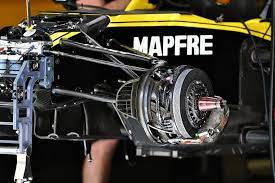The brakes used in a Formula 1 car need to be superb to cope with extreme racing challenges. However, it might surprise you to learn that the brakes are very similar to regular car brakes. Formula 1 cars use disc brakes with rotating discs that are squeezed between brake pads using a hydraulic calliper. But they have unique qualities that enable them to cope with the harsh and fast-paced conditions of the racing circuit.

ABS Anti-Skid Technology Ban
If too much braking power is applied, the brakes can lock as the control is greater than the ability of the tyres to grip the road. This is where the anti-locking ABS braking technology helps slow a car safely and prevent locking.
ABS anti-skid systems were banned in Formula 1 in the 1990s, though they are popular safety features in regular cars. Due to the ban, F1 car drivers need to use great skill to brake without locking the system. However, there are some other helpful technologies.
Twin-Hydraulic Braking System
Each F1 car must have a hydraulic braking system with two circuits. There are different reservoirs for the back and front wheels, which means a driver can still brake even if one system locks down. In 2014, F1 cars were allowed to use electronic rear brake systems, which give better balance and stability. For more information on a Hydraulic Power Unit, go to a site such as hydraproducts.co.uk/Hydraulic-Power-Units/Standard-Power-Units

A racing driver can manually control the braking power to each circuit, which helps stabilise the handling. This control is exciting to see close-up from the vantage point of a luxury viewing platform, and it is easy for race fans to reserve such a viewing experience.
Turning Heat Energy into Electrical Energy
The materials used are the main area where F1 car brakes are more sophisticated than road cars. The brake discs are made from carbon fibre, which can work at higher temperatures than the steel discs found in ordinary cars. The vehicles have to have an excellent cooling mechanism to cope with the high temperatures that the brake discs operate under during racing conditions.
F1 car brakes are highly efficient with short braking distances. Another innovation is that the energy created from braking is not lost as heat, with much conserved and returned to the car as electrical energy through the Energy Recovery System (ERS).
